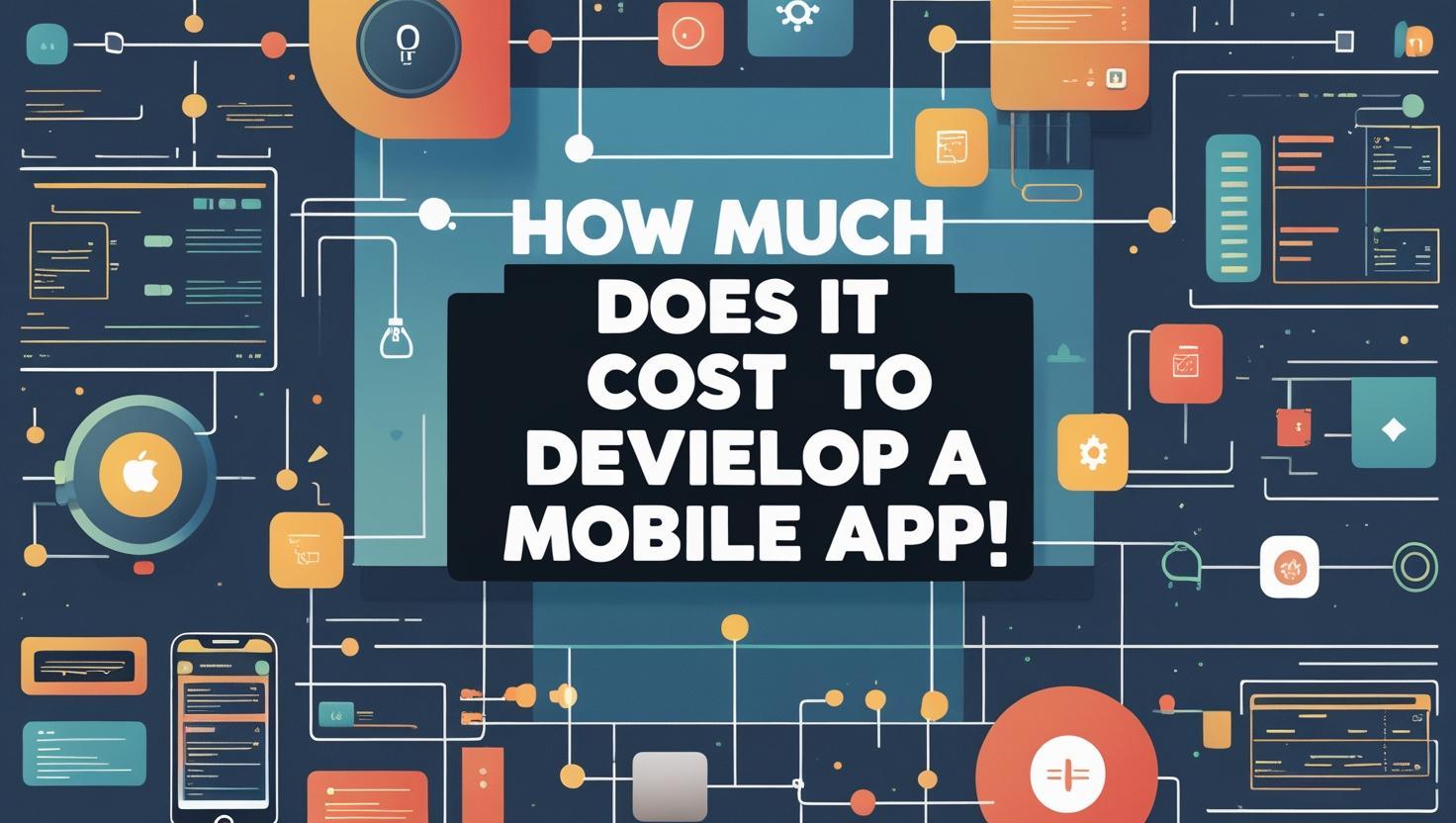In 2024 alone, there were more than 250 billion downloads of mobile apps. This shows how much digital solutions are a part of our daily lives. Because of how common digital technology is, business owners often ask a very important question: how much will it cost to make a mobile app in 2025? Many businesses, from new startups to long-established ones, are trying to figure out their digital footprint. When you buy something with a set price, you know exactly how much it will cost. But app development is different because it involves a lot of different factors, making it hard to come up with a single, final number. Any business that wants to make a great mobile app must first understand the factors that are at play.
The App Development Puzzle
The confusion about how much it costs to make a mobile app comes from the fact that each project is different. Think about building a house. The final cost depends on the size of the house, the materials used, how complicated the design is, and even the local job market. In the same way, the price of a mobile app depends on its built-in features, the platforms it works on, how complicated the design is, and how skilled the development team is. As an SEO Manager who helps businesses, I've seen that a lot of early questions mix up basic utility apps with complex platforms that need complicated integrations. The first step in coming up with a realistic pricing strategy for app development is to clear up this misunderstanding.
Important Things That Affect the Cost of Making Mobile Apps
Features and Complexity
This is probably the most important thing that affects how much an app costs. A simple app with basic features will always cost less than a complicated app with a lot of advanced features. Think about these levels of difficulty:
Basic Apps (Minimum Viable Product - MVP): These usually have basic features like a login, a profile, and a way to show information. Think of apps for basic content viewing, simple calculators, or static brochures. The goal of developing an MVP is to test a main idea with the most important features. Apps with a medium level of difficulty: Include things like personalised user interfaces, backend databases, API integrations (like payment gateways and social media logins), push notifications, and geolocation services. A lot of e-commerce apps and simple social networking tools fit into this group. High Complexity Apps: These are complicated apps that need real-time synchronisation, a lot of API integrations, advanced analytics, AI/ML features, custom animations, complicated security protocols, and maybe even connections to IoT devices or business systems. Ride-sharing apps, complicated fintech solutions, and content platforms that are very tailored to each user are some examples.
Here is a rough estimate of how long it will take based on how hard it is:
| Feature Difficulty | Estimated Hours of Development (Per Platform) | Cost Range (USD, per Platform) |
| Basic (MVP) | 200 to 500 hours | $15,000 to $37,500 |
| Medium Level of Difficulty | Five hundred to a thousand hours | $37,500 to $75,000 |
| Very complicated | More than 1000 hours | $75,000 to $200,000 or more |
These numbers are usually based on an average hourly rate of $75 per developer, but this rate can vary a lot depending on where the developers are located and which agency they work for.
Choose a platform: iOS, Android, or Cross-Platform
The target operating system (OS) has a big effect on how development is done and how much it costs.
Native Development for iOS or Android
Making separate apps for each platform (Swift/Objective-C for iOS and Java/Kotlin for Android) is usually the best way to get the best performance, security, and access to features that are only available on that platform. But it means two separate development cycles, which makes the mobile app budget much higher.
Building for multiple platforms: Frameworks like React Native, Flutter, and Xamarin
These let developers write code once and use it on both iOS and Android. There may be some trade-offs in performance, native look and feel, or access to cutting-edge device features, but it will save you money and get you to market faster. The lower prices for app development can save a lot of money, making it a good choice for many projects.
Design and User Interface (UI/UX)
A good user interface (UI) and an easy-to-use user experience (UX) are not just nice to look at; they are essential for an app to be successful. Custom, creative, and user-centred design takes time and skilled professionals. Templates are less expensive, but they don't stand out and may not appeal to the target audience. The focus on user research, wireframing, prototyping, and iterative design cycles is directly linked to higher, but justified, design costs. Users often really like apps that are easy to use and look good.
APIs and Backend Infrastructure
For data storage, user authentication, and logic processing, most apps need a server-side component. This "backend" infrastructure, along with Application Programming Interfaces (APIs) that let the app talk to outside services, is a big part of the equation for how much it costs to make a mobile app. The price is directly affected by how complicated and big your backend needs are, from simple cloud-based solutions to strong custom servers.
Updates and Maintenance
An app is not something you can just set and forget. Bug fixes, performance improvements, security updates, OS compatibility, and new feature releases will always cost money. Including a maintenance budget, which is usually 15–20% of the initial development cost each year, helps avoid major problems later on. A common mistake that I tell my clients to avoid is ignoring this aspect.
The Team That Builds: Where Knowledge Is Worth Something
Freelancers: Usually the cheapest option, good for simple projects or specific tasks. But the client is mostly in charge of project management, and things can change. Agencies with a Small Number of Employees: Give your team (designers, developers, and project managers) more support and pay attention to each person. Their prices are usually in the middle. Big Agencies and Businesses: Charge high rates because of their years of experience, wide range of skills, established processes, and ability to manage big, complicated projects. The higher cost of mobile app development is worth it because of the wide range of services they offer. Hourly rates are very different: $100 to $250+ an hour in North America and Western Europe In Eastern Europe, it costs $50 to $150 per hour. Asia and South America: $20 to $70 an hour It's easy to want to go with the lower rates, but remember the saying, "You get what you pay for." Sometimes, options that are too cheap can hurt quality, communication, and meeting deadlines.
For the latest costing info look for mobile app development company in new york.
Common Mistakes and How to Avoid Them
There are a number of things that can unexpectedly raise the cost of making an app: Scope Creep: Adding new features after the agreement without control can make costs and timelines go up by a lot. Clearly define your MVP and stick to it at first. Poor Planning: Not having clear requirements and user stories means that work has to be done again and time is wasted. Planning ahead of time for development saves a lot of money. Ignoring costs after launch: Many people only think about the initial development and don't think about the ongoing costs that are just as important. Picking the Least Expensive Choice Without thinking: Putting low cost ahead of quality or cultural fit can cause technical debt, delays in the project, or a product that can't be used. Poor Communication: Not being clear or talking to the development team often leads to misunderstandings and having to do things over. There must be clear, consistent communication.
Smart ways to set prices for app development
To successfully manage your mobile app budget, you need to be able to see the future: Make a clear definition of an MVP: Focus on the features that are absolutely necessary for launch. More features can be added in later versions. This lowers the cost of developing apps at first and lets the market test them. In-depth research and documentation: Make detailed user flows, wireframes, and requirements. A project that is well-documented helps developers give accurate estimates and cuts down on guesswork. Put Features in Order: Put features into groups based on how important they are (must-have, nice-to-have, later-phase). This helps keep the scope in check. Think about cross-platform development to save money: Cross-platform frameworks can save a lot of money if native performance isn't a big deal. Agile Methodology: Iterative Development Short, iterative cycles of development give you the freedom to change course, get feedback early, and avoid expensive reworks. Get a lot of quotes: When looking at proposals from different agencies, don't just look at the price; also look at how well they understand your vision, portfolio, and communication style.
A Developer's Point of View: Expert Insight
A seasoned developer would say that clear communication and detailed specifications are the best ways to avoid problems on a project. Sarah Chen, a senior app developer, says, "The less vague a client is in their initial brief, the more accurate our estimates become and the smoother the development lifecycle." A small change in your vision could mean weeks of coding and testing, which could add a lot to the final cost of developing the mobile app. This rings true for me; vague ideas almost always lead to more hours and, as a result, more money spent.
Tools that help you set your mobile app budget
Modern development uses a set of tools that affect both cost and efficiency:
-
Cloud Services: Platforms like AWS, Google Cloud, and Azure offer scalable infrastructure, often on a pay-as-you-go basis, so you don't have to buy expensive dedicated servers right away.
-
Tools for analytics: Google Analytics, Mixpanel, and Firebase give you important information about how users act, which helps you improve future versions and make sure you spend your money wisely on features that users really need.
-
Project Management Software: Jira, Trello, and Asana help the development team stay organised, keep track of things, and talk to each other. This makes things run more smoothly and keeps app development costs down.
-
Figma, Sketch, and Adobe XD are prototyping tools that let designers make interactive prototypes quickly and get feedback from users without having to write any code. This cuts down on rework.
Questions that are often asked
Finding out how much your digital business really costs: Figuring out how much it costs to make a mobile app is not a simple task. The price depends on many things, such as how complicated the app is, what features you want, what platform you want it to work on (iOS, Android, or cross-platform), how advanced the design is, and how much your chosen development team charges by the hour. An accurate estimate is based on a clear project scope.
How do feature sets affect the price of your app project?
The cost of making a mobile app is greatly affected by the features it has. Basic apps with core functions usually take less time and money to make. As features get more complicated, like advanced integrations, AI components, real-time data processing, or custom animations, the number of hours needed to develop them goes up a lot, which means more money spent.
Which platform choice has an impact on the total cost of app development?
The cost of making a mobile app depends on whether you want to make it for iOS, Android, or both. When you develop natively for each OS, you usually have to do it separately, which doubles the cost. Cross-platform frameworks can save you a lot of money by using a single codebase, even though they may sometimes have small performance trade-offs.
How does ongoing maintenance affect the budget for my app?
People often don't realise how much it costs to develop a mobile app because of maintenance. Apps need to be updated regularly after they are released to fix bugs, improve performance, add security patches, and make sure they work with the latest version of the operating system. Setting aside 15–20% of the initial development cost each year for ongoing support keeps the software from becoming outdated and keeps users happy.
How long does it usually take to make a mobile app?
The cost of making a mobile app is directly related to how complicated it is. It could take 2 to 4 months to make a simple MVP. It could take 5 to 9 months to make an app that is not too hard. Very complicated apps can take 10 to 18 months or longer to make. These timelines take into account the design, development, thorough testing, and deployment phases.
Suggestions
To successfully navigate the world of mobile app development costs, you need a clear plan and a practical approach.
Don't be afraid to spend money on careful planning and thorough documentation; this foresight greatly reduces the chances of going over budget and being late.
Focussing on a lean Minimum Viable Product (MVP) for the first launch will not only help you stick to your mobile app budget, but it will also give you a chance to get feedback from users that will help you improve future versions.
When looking for potential development partners, don't just look at their hourly rate. Check how well they communicate, how well they've done on past projects, and what they can offer you.
Start your mobile app journey with all the information you need. If you're ready to turn your idea into a strong mobile app and want to know exactly how much it will cost to develop it for your specific needs, get in touch with a professional right away. A personalised consultation can help you understand the unique details of your project and show you the best way to move forward.



